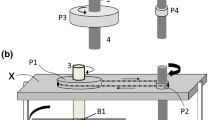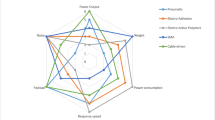Abstract
Conventional actuators still play the most important roles in motion control of automated machines. However, for advanced machines and instruments with higher performance, the conventional motors seem to be difficult to satisfy the coming sophisticated demands. So, the development of innovative actuators is recognized as one of the most important subjects of the key technology for next generation. Present state of the technology related to innovative actuators is introduced with some examples developed in a national project for new actuators. Essentials to develop a new actuator and to put it to practical use are also commented.
Similar content being viewed by others
References
T. Higuchi, K. Suzumori and S. Tadokoro, Next-Generation Actuators Leading Breakthroughs, Springer Verlag, London, UK, (2010).
M. F. M. Sabri, T. Ono and M. Esashi, Modeling and Experimental validation of the performance of a silicon XY-microstage driven by PZT actuators, Journal of Micromechanics and Microengineering, 19, (2009) 095004-1–5004-9.
K. Takemura, H. Kozuki, K. Edamura and S. Yokota, A micromotor using electro-conjugate fluid — Improvement of motor performance by using saw-toothed electrode series, Sensors and Actuators A: Physical, 140 (2007) 131–137.
Y. Yamanishi, S. Sakuma, K. Onda and F. Arai, Biocompatible Polymeric Magnetically Driven Microtool for Particle Sorting, Journal of Micro and Nano Mechatronics, 4(1) (2008) 49–57.
T. Higuchi, Y. Yamagata, K. Furutani and K. Kudo, Precise Positioning Mechanism Utilizing Rapid Deformations of Piezoelectric Elements Proc.of IEEE MEMS Workshop, Napa Valley, USA, (1990) 222–226.
A. Saito, Y. Nakagawa and T. Maeno, Non-linear Dynamic Analysis of Traveling-Wave-Type Ultrasonic Motors, IEEE Transactions on Ultrasonics, Ferroelectrics, and Frequency Control, 55(3) (2008) 717–725.
T. Shigematsu and M. K. Kurosawa, Friction Drive of an SAW Motor, IEEE Transactions on Ultrasonics, Ferroelectrics, and Frequency Control, 55(10) (2008) 2288–2297.
K. Motoo, F. Arai, T. Fukuda, M. Matsubara, K. Kikuta, T. Yamaguchi and S. Hirano, Touch sensor for micromanipulation with pipette using lead-free (K,Na)(Nb, Ta)O3 piezoelectric ceramics, Journal of Applied Physics, 98 (2005) 094505/1–094505/6.
E. Li, R. Sasaki, T. Hoshina, H. Takeda and T. Tsurumi, Miniature Ultrasonic Motor Using Shear Mode of Potassium Sodium Niobate-Based Lead-free Piezoelectric Ceramics, Jpn. J. Appl. Phys. 48 (2009) 09KD11.
S. Wada, K. Takeda, T. Muraishi, H. Kakemoto, T. Tsurumi and T. Kimura, Domain Wall Engineering In Lead-Free Piezoelectric Grain-Oriented Ceramics, Ferroelectrics, 373(1) (2008) 11–21.
K. Kiyohara, T. Sugino, I. Takeuchi, K. Mukai and K. Asaka, Expansion and contraction of polymer electrodes under applied voltage, Journal of Applied Physics, 105 (2009) 63506–63613.
S. Saito, Y. Katoh, H. Kokubo, M. Watanabe and S. Maruo, Development of a soft actuator using a photocurable ion gel, J. Miromech. Microeng., 19 (2009) 035005.
D. Sasaki, T. Noritsugu and M. Takaiwa, Wearable Master-Slave Training Device for Lower Limb Constructed with Pnuematic Rubber Artificial Muscles, Jounal of Roboticss and Mechatronics, 20 (2008) 466–472.
K. Tsuchiya, Y. Todaka and M. Umemoto, TEM Investigation of Intermediate Phase Transformation and Micromodulation in Ni-Mn-Ga Ferromagnetic Shape memory Alloys, Mater. Sci. Tech., 24 (2008) 920–926.
Y. Okimori, T. Inamura, H. Hosoda and K. Wakashima, Diffusion Bonding of Co to TiAu High Temperature Shape Memory Alloy, Materials Transactions, 49 (2008) 1998–2005.
T. Higuchi, A. Horikoshi and T. Komori, Development of an actuator for super clean rooms and ultra high vacua, Proc of 2nd International Symposium on Magnetic Bearings, Tokyo, Japan, (1990) 115–122.
H. Yasui, A. Yamamoto and T. Higuchi, Non-Contact Levitation control System for Electrostatic Motor, Proc. of 8th International Symposium on Magnetic Bearings, Mito, Japan, (2002) 175–180.
T. Niino, S. Egawa and T. Higuchi, High-Power and High-efficiency Electrostatic Actuator, Proc. 1993 IEEE Workshop on Micro Electro Mechanical Systems, (1993) 236–241.
T. Niino, T. Higuchi and S. Egawa, Dual Excitation Multiphase Electrostatic Drive, Proc. 1995 IEEE IAS annual meeting (1995) 1318–1325.
A. Yamamoto, T. Nishijima, T. Higuchi and Akio Inaba, Robotic Arm using Flexible Electrostatic Actuators, Proc IEEE International Symposium on Industrial Electronics (ISIE 2003), (2003) BF–001360.
Z. G. Zhang, N. Yamashita, M. Gondo, A. Yamamoto and T. Higuchi, Electrostatically Actuated Robotic Fish: Design and Control for High-Mobility Open-Loop Swimming, IEEE Transactions on Robotics, 24(1) (2008) 118–129.
M. Rajendra, A. Yamamoto, T. Oda, Y. Hirano, H. Kataoka, H. Yokota, R. Himeno and T. Higuchi, Motion Generation in MR Environment Using Electrostatic Film Motor for Motion Tagged Cine-MRI, IEEE/ASME Transactions on Mechatronics, 13(3) (2008) 278–285.
Author information
Authors and Affiliations
Corresponding author
Additional information
Toshiro Higuchi received the B.S., M.S., and Ph.D. degrees in Precision Machinery Engineering from University of Tokyo, in1972, 1974, and 1977, respectively. From 1978 to 1991, he was an associate professor at the Institute of Industrial Science (IIS), University of Tokyo. Since 1991, he has been a professor in the Department of Precision Engineering, University of Tokyo. He was the Leader of the Higuchi Ultimate Mechatronics Project, Kanagawa Academy of Science and Technology from 1992 to 1997. Since 2002, he has been a Director of Nano Control Company, Ltd.. His current research interests include mechatronics, magnetic bearings, electrostatic actuators, robotics, and manufacturing
Rights and permissions
About this article
Cite this article
Higuchi, T. Next generation actuators leading breakthroughs. J Mech Sci Technol 24, 13–18 (2010). https://doi.org/10.1007/s12206-009-1153-2
Received:
Revised:
Accepted:
Published:
Issue Date:
DOI: https://doi.org/10.1007/s12206-009-1153-2




